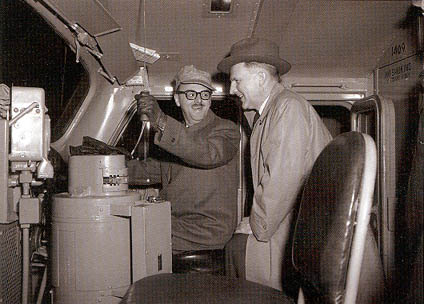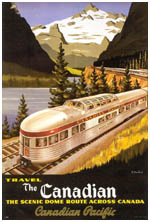|
Winter
2005

Canadian
Pacific Railway Employee Communications
Room 500 401-9th Ave S.W. Calgary AB T2P
4Z4

BUCK CRUMP'S SILVER STREAMLINER
Momentum correspondent Greg
Gormick draws upon conversations with CPR's retired chairman about his fervor for
the diesel locomotive
and the famous train he launched 50 years
ago.

When
Quebec premier Maurice Duplessis cancelled his appearance at the inaugural departure
from Windsor Station, Montreal's colourful mayor, Jean Drapeau (pictured here with
N.R. Crump), stood in for him.
Fifty years ago, the CPR revolutionized rail
travel in Canada with the launch of what turned out to be the last
built-from-scratch streamliner on this continent, "The
Canadian".
 Although the stainless steel, dome equipped beauty was the work of thousands of CPR
employees and industry suppliers, it really owed its existence to one man:
N.R. "Buck" Crump. His godfather-like role in the birth and
baptism of the train began in 1944 when, as a newly appointed
vice-president, he oversaw the work of a committee evaluating
equipment needs in the post-war era. And he wasn't pleased with what he
saw at first.
Although the stainless steel, dome equipped beauty was the work of thousands of CPR
employees and industry suppliers, it really owed its existence to one man:
N.R. "Buck" Crump. His godfather-like role in the birth and
baptism of the train began in 1944 when, as a newly appointed
vice-president, he oversaw the work of a committee evaluating
equipment needs in the post-war era. And he wasn't pleased with what he
saw at first.
"The CPR mechanical men were fine and very competent fellows", Crump told
me during and interview in 1983. "But they were still in love with steam
engines and coaches that were basically Canadian versions of what they'd seen on
"The Royal Scot" when it was brought over here from Britain for a tour in
the 1930s. I knew we needed something totally different if we were going to compete
with flashy new cars and airplanes".
What Crump wanted was, above all, diesel power. And after a few trips to the U.S.,
he also wanted the revolutionary Budd Company's stainless steel passenger cars in
which he rode on some of America's finest trains. Years later, Crump could recall
in detail the reconnaissance missions he made on such great streamliners as
"The Empire State Express", "The Super Chief", and the
Burlington Route's fleet of sleek "Zephyrs". The one that impressed him
most was the Chicago-Oakland domeliner, "The California
Zephyr", which was accurately billed at its creation in 1949 as "the most
talked about train in America". It became the CPR's model, but with a Canadian
accent.
"We had Budd's complete cooperation in the design and construction of the
equipment", recalled Crump. "We insisted on maximum Canadian content, too.
They were quite happy to buy nearly half of the components from Canadian firms and
have them shipped to their Philadelphia plant for installation".
When the news of the CPR's decision to spend $40 million for a stable of 173 cars
hit the Canadian press, it sent the railway's image soaring. The view was that CPR
was leading Canadian transportation into a bold, new age. Not only would the new
rolling stock and complementary diesel power be used to create a whole new
transcontinental train, enough would be bought to incrementally improve several
other trains, as well. It was, said Crump, only the beginning of a
top-to-bottom overhaul of the CPR's passenger fleet; modern trains for
a modern Canada.
For two years, the Canadian public and the worldwide travel industry were fed a
steady diet of articles and events in anticipation of the train's launch.
Enthusiasm surged through the CPR ranks. One suggestion that flew with management
came from an enthusiastic employee in the paymaster's office named Omer Lavallee.
Destined to one day become the CPR corporate historian & archivist, young Omer
provided lists of names for the new cars to reflect the elegance of "The
World's Greatest Travel System", as well as Canada's natural beauty and its
bilingual heritage.
Thanks to Omer, the dining cars (never diners!) were named for CPR hotels and their
restaurants. The sleeping cars became either "Chateaux" or
"Manors". The gracefully tapered, dome-topped
sleeper-lounge-observation cars that gave each Canadian an elegant
tail-end were bestowed with the names of Canadian national parks.
Far from public view, intense activity preceded the first "sailings" of
the sassy streamliner. One hush-hush project was the operation of a
test train from Montreal to Vancouver to see how much time could be shaved from the
87-hour schedule of the flagship "Dominion". The test train
made it in 71 hours. Many operating personnel felt it could do even better if
pushed.
Crump, however, rejected the pursuit of more speed. "After travelling at 100
mph on some of those American name trains", he said. "I thought it would
be better if passengers had their soup in the bowls rather than in their
laps".
On 24 Apr 1955, Crump's pride and joy took to the rails in Montreal,
Toronto, and Vancouver. And no one was ever a prouder father. "The
Canadian" was an instant hit and was booked solid that summer.
To visitors from abroad, "The Canadian" soon became as synonymous with
Canada as maple leaves and red-coated Mounties. Icing on Crump's cake
came 10 days later, when he was appointed president of the railway where he had
started as a labourer 35 years earlier.
But tragedy was brewing under the surface. The federal and provincial governments
were stuffing money into highway construction and air facilities like they were
fattening up turkeys for Thanksgiving. As with all North American railways, the
CPR's passenger trains - even "The Canadian" - were soon drowning in
deficits. It was no contest.
"What it came down to was this", Crump said years later. "I
misjudged the market and the extent to which the government was going to subsidize
the other modes of travel. "The Canadian", along with the White Empress
transatlantic steamships and the Budd rail diesel cars (for other passenger routes)
were the worst investments I ever made".
The plan to buy more stainless steel cars was quietly shelved, the most unprofitable
trains were pruned from the timetable and the deathwatch began. Crump told the media
it was a step taken "most reluctantly and regretfully". He went on to say
he still believed "The Canadian" would continue to run for many more
years. And run well.
As Crump said, "At least in my time with the CPR, there was never any
slackening of the standards on "The Canadian". I think it was, for a time,
the finest intercity passenger train in North America, maybe even the
world".
This Momentum magazine article is copyright 2005 by
Canadian Pacific Railway and is reprinted here with their permission. All
photographs, logos, and trademarks are the property of the Canadian
Pacific Railway Company.
|